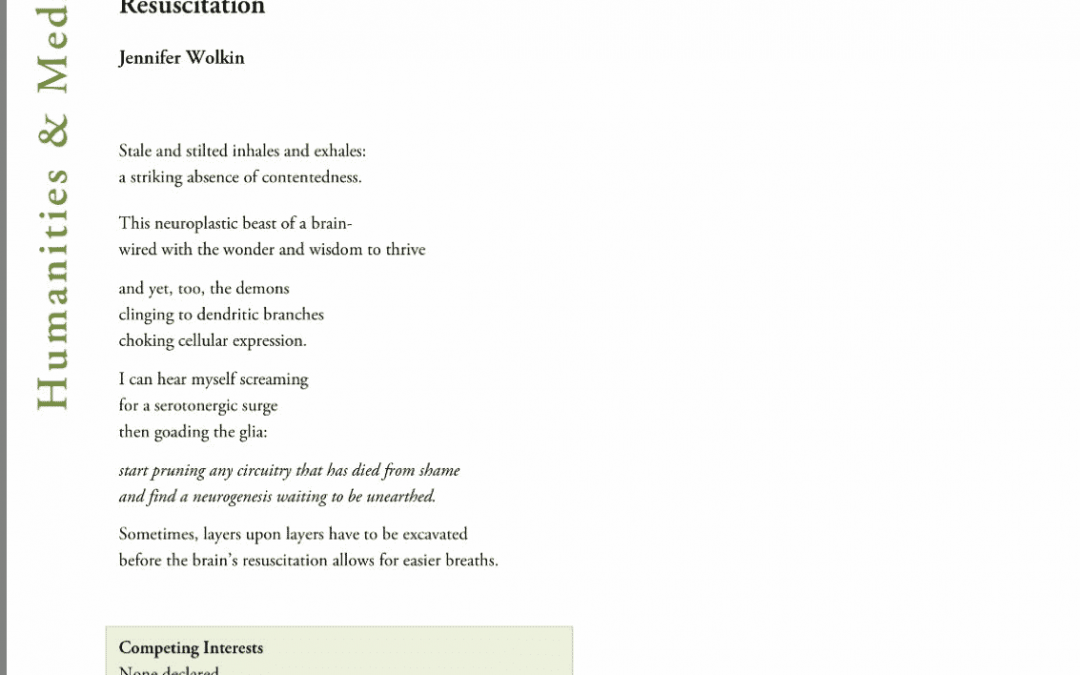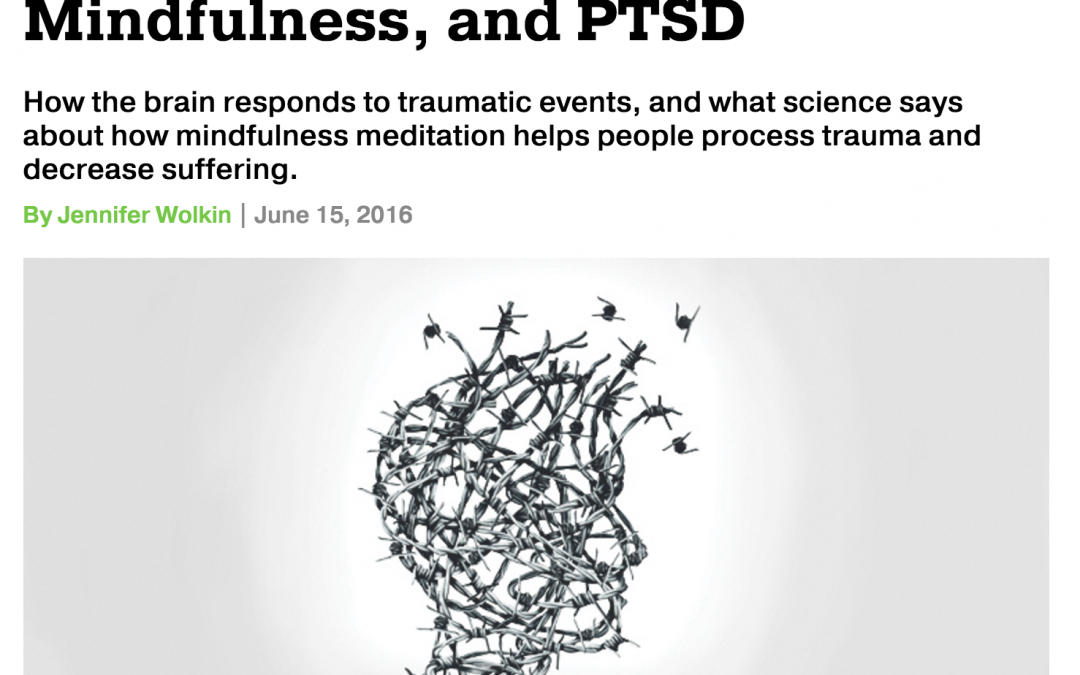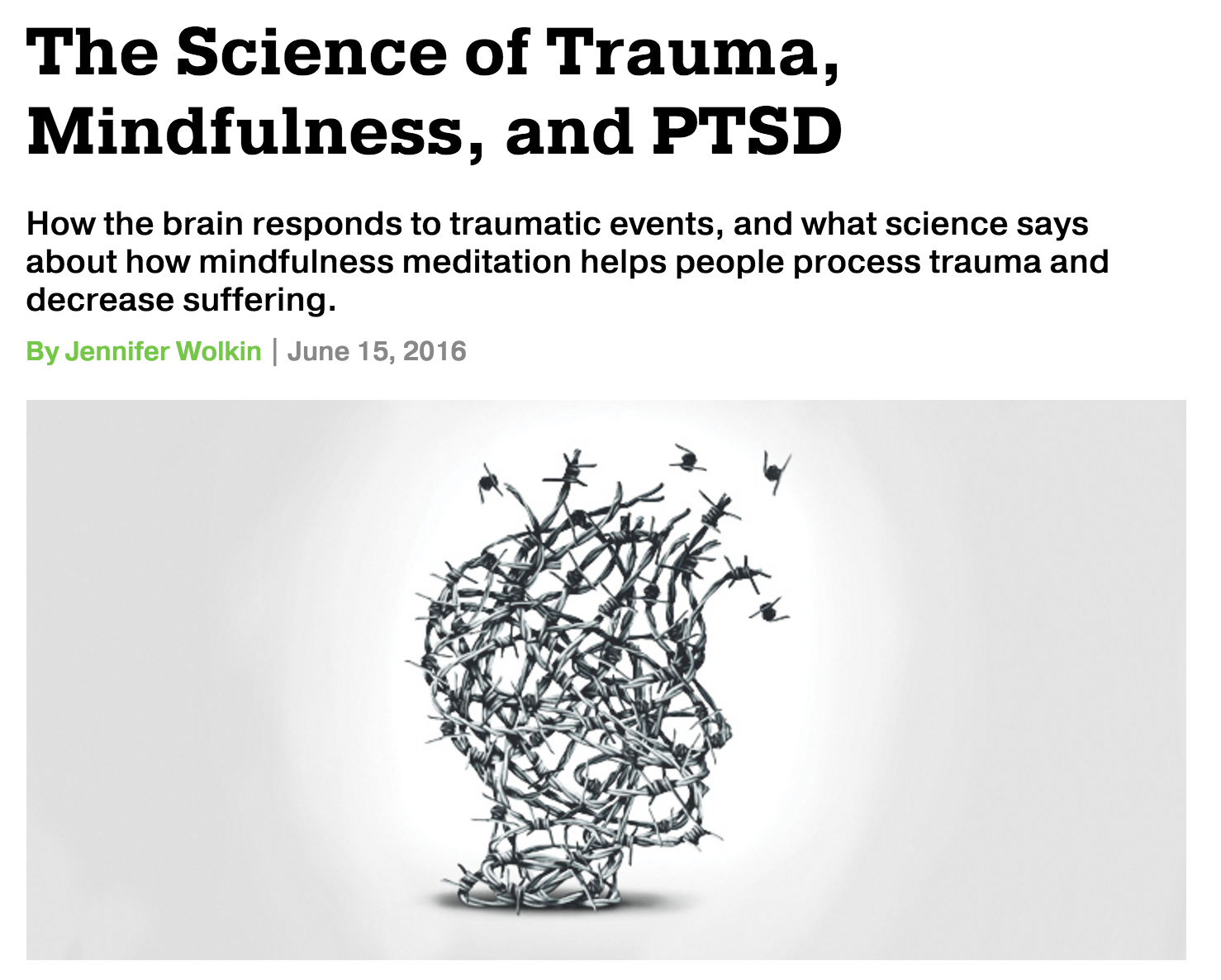
by Jennifer Wolkin | Jul 5, 2018 | Blog, Brain Health, Mindfulness, PTSD, Wellness
On the evening of March 26th, 2012, Yvonne Kent Pateras suffered a massive hemorrhagic stroke, leaving her unable to speak or move. She also experienced “locked-in” syndrome. These are Yvonne’s own words regarding the traumatic stroke she experienced:

“I had the experience of knowing what was happening to me from the beginning. I felt a sinus rhythm in my head becoming louder. I tried to center myself, but it was over before I had time to act. I opened my mouth to shout for help-the noise that left my body was the most primordial noise. My beautiful voice had been replaced by the noise of a wounded beast. I wouldn’t hear another word for the next for 3 months. I knew that I had not only suffered a stroke, I was paralyzed and locked in. I couldn’t tell my family that I knew what was going on. I tried to just keep my neurons busy and alive. I did simple counting exercises to stay calm and occupied-to keep my adrenaline levels under control. I was determined to survive.”
After four months in the hospital, to everyone’s surprise, and with extraordinary courage, Yvonne was able to regain speech and movement. Yet, in a span of approximately ten months, she suffered three ischemic strokes, and another hemorrhagic one. Since different kinds of strokes require different treatments, medical care was challenging.
Yvonne persevered. She said that recovery required “endless effort.” She can now walk without difficulty. She has a light speech impediment and lost some functioning in her right hand.
As we now know, with post-traumatic growth, trauma like this can often serve as a catalyst for a profound awakening to an emotional and spiritual transformation. Yvonne’s awaking came in the form of writing poetry.

“Following the stroke I went through a spell of re-learning, like being born again. Feelings were overpowering my mind’s concentration and understanding. Writing verses were facilitating the expression of my feelings. Publishing my work also gave me upmost satisfaction, particularly as the response by other stroke victims was so moving. Poetry takes the weight off my legs, gives me wings!!!”
You can find Yvonne’s poetry in her book, Stroke Journeys, by clicking on this link.

by Jennifer Wolkin | Jul 4, 2018 | Blog, Mindfulness, PTSD, Wellness
There is research that those experiencing PTSD reported improved well-being in response to poetry therapy. This might be the case because a hallmark of having experienced trauma is the subsequent difficulty processing the experience, which results in avoiding and suppressing associated emotions/memories.
Poetry therapy has provided an outlet for those suffering with PTSD to start to integrate many of these feelings, and even more so, to start to reframe the traumatic experience.
Poetry therapy itself is a bit abstract to describe, but there are a few ways to engage with it. Here is a multi-model poetry therapy practice developed by Nicholas Mazza, the founding and continuing editor of the Journal of Poetry Therapy.
According to Mazza’s model, poetry therapy involves three main components:
- Receptive/prescriptive: This part of therapy involves the clinician/therapist reading a poem out loud, and then subsequently encouraging the client to react to it, either verbally, non-verbally, or both. The therapist might even prompt: “Is there a particular line in the poem that resonated with you?”, or “I noticed you started to become teary-eyed when I read this line…”
- Expressive/creative: This entails actual creative writing. The therapist promotes stream of consciousness writing that might aid in discovering blocked emotions, parsing felt emotions, or retrieving memories that are difficult to articulate. The therapist might offer a prompt to help someone get started.
- Symbolic/ceremonial: This includes working with metaphor/simile to help further explain emotions that are hard to describe in a more literal sense. The ceremonial part may consist of writing a letter to someone they may have lost and then burning it.
The efficacy of poetry therapy is still being studied. Most of the empirical evidence for its effectiveness comes through James Pennebaker’s (a pioneer in the field of Positive Psychology) work in the therapeutic use of expressive writing. His studies have indicated that the use of expressive writing, even for as little as 15 minutes over the course of 4 days, resulted in positive health effects. In addition, his initial work dealt with the use of expressive writing to heal wounds from traumatic stressful events.
One case in point is that in the aftermath of 9/11, poetry was utilized as a healing mechanism. According to a New York Times article on October 1, 2001:
“In the weeks since the terrorist attacks, people have been consoling themselves—and one another—with poetry in an almost unprecedented way … Improvised memorials often conceived around poems sprang up all over the city, in store windows, at bus stops, in Washington Square Park, Brooklyn Heights, and elsewhere. …”
In some ways poetry gives us the way to speak about the unspeakable. It is more and more common for those suffering with medical challenges to write their story, many times in poetic form, to aid in their own healing. As always, it is crucial to note that just like with mindfulness approaches to trauma, poetry therapy is most often used in conjunction with other therapies.
On a personal note, I’m particularly drawn to this type of therapy and recently started studying for my MFA at Queens College. I am touched by the profound pain that is both individually and collectively felt, how this pain can displace someone from others and their selves, and yet, the profound capacity for resilience, healing, and growth. Aside from writing my own work, I hope to employ poetry as a technique to help my clients say what they couldn’t otherwise say.
Here’s an example of a poem that I recently published in the British Journal of Medical Practice in this vein:

by Jennifer Wolkin | Jul 3, 2018 | Blog, PTSD
By way of full-disclosure, I’m tearing up as I write this. In the last few years alone, we have seen a rise in mass school shootings; that is, the death of innocent children, adolescents, and their adult mentors/teachers in cold blood.
I too, continue to grapple with the snuffing out of so many lives, and the lack of response to these deaths that somehow don’t seem to create change. Actually, most school shootings aren’t even talked about.
According to a non-profit that tracks gun violence in America, as of April 20th 2018, there have been 17 shootings since the February shooting at the Marjory Stoneman Douglas High School in Parkland, Florida which launched the Never Again movement. You read that number correctly.
I don’t want to get too political here, but as a mental health practitioner and staunch advocate, I want to go on record saying that gun violence is not a mental health issue. Is mental health sometimes a component in these shootings? Sure. Yet, let’s be clear. The rise of school shootings is not attributable to a national mental health crisis. It is far too easy for someone to get a gun in this country. No matter which side of the gun control debate you are on, it is insulting with those who suffer with mental health to be accountable for this.
Here’s some info taken straight from MentalHealth.gov to keep in mind:
Myth: People with mental health problems are violent and unpredictable.
Fact: The vast majority of people with mental health problems are no more likely to be violent than anyone else. Most people with mental illness are not violent and only 3%–5% of violent acts can be attributed to individuals living with a serious mental illness.
Now that I made that clear, I want to discuss PTSD in the context of these shootings.
Undoubtedly, these shootings will impact the victim’s families, friends and communities forever – some might even develop PTSD, as they are certainly at risk, especially those who survived and witnessed the events.
Of course, what we have seen come out of the Parkland shooting is no less than a post-traumatic growth response (learn more in my PTSD packet); while this doesn’t mean the survivors aren’t deeply suffering, many have been able to utilize this suffering as fuel to advocate for gun control in a way it seems that no other organization or group of individuals has been able to before. Their efforts have affected real change, and I pray the change continues.
What I want to address is the idea of virtual trauma. We, as a nation, are privy to these events either in real time, or moments after. Sometimes, the media coverage is more gruesome and detailed than at others. Regardless, we, as a nation, are at risk for PTSD even if we were not directly affected. Whether we were involved or not, these accounts bring up a real sense of danger and deep concern about our and our loved one’s safety.
According to research in the early 2000’s, approximately 15 to 36 percent of the population that did not experience violence directly, will still develop post-traumatic stress disorder (PTSD) symptoms.
The impact of trauma has a wide range. Even just hearing about the event can shatter our assumptions about our world. You see, tragedies like these reverberate in the hearts and minds of much of humanity, as it rips through the basic foundation that we lay our trust upon. That is, we don’t expect people to just shoot other human beings in cold blood. So, it seems that trauma’s effect surpasses the psycho-neurobiological impact of experiencing a direct threat to one’s own life.
According to psychologist Janoff-Bullman, what a mass trauma like this does is challenge our assumptions and brings them into question.
These assumptions may include:
- “the world and people are intrinsically good”
- “good people experience good things”
- “the world is safe”
- “the world is just”
Undoubtedly, these assumptions aren’t necessarily true, but can be healthy and adaptive. For many of us, these very assumptions help us get out of bed in the morning and actually go about our lives and are necessary for meaningful experiences and interpersonal relationships.
The figurative ground we walk on becomes shakier and shakier with each shooting. If you notice that after an event you start feeling more irritable, anxious, like you have lost control, depressed, have trouble sleeping and anything else that is not your baseline and does not seem to be going away, please reach out for help.
![RECOGNIZING THE COMPLEX TRAUMA OF PROLONGED VIOLENCE]()
by Jennifer Wolkin | Jul 2, 2018 | Blog, PTSD, Relationships, Stress

Children inside U.S. Customs and Border Protection detention facility at the Rio Grande Valley Centralized Processing Center in Rio Grande City, Texas. CBP/via REUTERS 2018
Complex trauma (C-PTSD) is still, relatively, a new term. It was coined in the 1990’s by trauma expert Judith Herman to connote repeated, prolonged (protracted, chronic) trauma. Another name sometimes used to describe the cluster of symptoms referred to as Complex PTSD is Disorders of Extreme Stress Not Otherwise Specified (DESNOS).
In reality, C-PTSD is still actually just a proposed disorder: because 92% of individuals with Complex PTSD also meet diagnostic criteria for PTSD. Complex PTSD is not added as a separate diagnostic classification.
I’m included in the group of many clinicians, however, who render it extraordinarily useful as a separate diagnosis. The current PTSD diagnosis often does not fully capture the severe psychological harm that occurs with prolonged, repeated trauma. While some symptoms may overlap, there are additional possible symptoms as well as possible conceptual differences.
Certainly, more precision in diagnosis leads to more precise treatment, and treatment for PTSD often fails with those experiencing C-PTSD. So, regardless of how one’s cluster of symptoms is labeled, it is crucial for a clinical to know the hallmarks of C-PTSD.
Another trauma expert, Dr. Christine Courtois, wrote that complex trauma is “a type of trauma that occurs repeatedly and cumulatively, usually over a period of time and within specific relationships and contexts.” In her well-known article, Understanding Complex Trauma, Complex Reactions, and Treatment Approaches, Dr. Courtois continues to summarize the characteristics of complex traumatic events as:
- Repetitive, prolonged, or cumulative.
- Most often interpersonal, involving direct harm, exploitation and maltreatment including neglect/abandonment/antipathy by primary caregivers or other ostensibly responsible adults.
- Often occur at developmentally vulnerable times in the victim’s life, especially in early childhood or adolescence, but can also occur later in life and in conditions of vulnerability associated with disability/disempowerment/dependency/age/infirmity, etc.
While there are many types of repeated trauma, it is most often experienced by children who are victims of long-term physical and/or sexual abuse. It also can include: experience in a concentration camp, POW situations, long-term domestic violence, prostitution/brothel situations, and organized child exploitation rings. In all of these circumstances, according to Dr. Herman, the trauma victim is generally held in a state of captivity, physically or emotionally, and in a situation in which there is no actual or perceived way to escape.
As I write this, I humbly and painfully think about how the current #BorderCrisis is a #MentalHealthCrisis, and how this will impact these children long-term. At the heart of C-PTSD is the idea of emotional neglect. When it comes to human beings making emotional attachments and proper development – we need more than just a bed to sleep in.
C-PTSD is not a psychological death sentence, so to speak, and there is treatment, but it needs to be recognized in general, and particularly with regards to what is going on at the border. People need to know that these children need help, and like any challenge, the earlier there’s intervention, the better.
People who experience chronic trauma often report symptoms that are additional to those seen in those diagnosed with PTSD. Dr. Herman initially identified this list of additional symptoms, which aren’t all included in the diagnosis of standard PTSD:
- Difficulty Regulating Emotions: May include persistent sadness, suicidal thoughts, explosive anger, or inhibited anger.
- Alterations in Consciousness:Includes forgetting traumatic events, reliving traumatic events, or having episodes in which one feels detached from one’s mental processes or body (dissociation).
- Alterations in Self-Perception:May include helplessness, shame, guilt, stigma, and a sense of being completely different from other human beings.
- Distorted Perceptions of the Perpetrator:Examples include attributing total power to the perpetrator, becoming preoccupied with the relationship to the perpetrator, or preoccupied with revenge.
- Difficulties with Relationships to Others:Examples include isolation, distrust, or a repeated search for a rescuer.
- Somatization and/or medical problems: Somatic reactions may relate directly to the type of abuse suffered (or any physical damage endured) and can involve all major body systems.
- Alteration in One’s System of Meanings:May include a loss of sustaining faith or a sense of hopelessness and despair.
Personal Clinical Note: Patients of mine who have experienced complex trauma, consistently describe feeling a lack of sense of self, very low self-esteem, extreme self-loathing, difficulty in interpersonal relationships, and an inability to discern between any real or potential threats to their minds and/or bodies. Often, and while this can happen in other diagnoses and from enduring a solitary trauma, it is more likely for someone who is chronically traumatized to engage in self-destructive and self-mutilating behaviors.
Many C-PTSD researchers and clinicians report that using the same treatment paradigm as one would use for PTSD (see below), might not cut it, and might even prove problematic. In response to this, the recommended course of treatment “involves the sequencing of healing tasks across several main stages of treatment. These stages include (1) pre-treatment assessment, (2) early stage of safety, education, stabilization, skill-building, and development of the treatment alliance, (3) middle stage of trauma processing and resolution, and (4) late stage of self and relational development and life choice.”

by Jennifer Wolkin | Jun 21, 2016 | Blog, PTSD
The meaning of human suffering has been the subject of psychological, philosophical, and poetic inquiry from time immemorial. Yet, there is an angle to trauma that is not talked about half as much as post-traumatic stress is. I’m referring to the upside of trauma, known in the psychological literature as post-traumatic growth (PTG). Research studies indicate that more than half of all trauma survivors report positive change.
PTG is radically changing and advancing our heretofore ideas of trauma and the notion that trauma inevitably means life-long damage. It is challenging the traditional view of trauma as solely destructive and making room for understanding that the struggle that ensues from trauma can be used as a springboard toward growth.

Given the potential zeitgeist shift, it is important to understand a bit more about what PTG really means.
Psychologists Richard Tedeschi and Lawrence Calhoun first coined the term PTG in 1996, after discovering some fundamental ways trauma was changing people for what was reported as “the better”. They define PTG as “the experience of positive change resulting from the struggle with major life crises.”
PTG has been noted as a result of many different types of trauma and stress, including illness, loss, sexual assault, and military combat. Post-traumatic growth is differentiated from resilience, which is akin to “bouncing back”, and connotes “bouncing even higher than before”.
In understanding the concept, however, it’s important to underscore that PTG in no way implies that trauma itself can be intrinsically positive; rather it can be a catalyst for positive change. Despite popular opinion to the contrary, experiencing growth after trauma is much more common than PTSD. While most people will suffer from post-traumatic stress in the aftermath of trauma, few will develop full-blown PTSD, and even of those, most will heal with therapy and time. Many more are likely to go on and become stronger. This doesn’t mean though that everyone who faces a traumatic event experiences growth.
It is also important to note that post-traumatic growth experiences aren’t exclusive from distress. So, just because growth is involved, does not mean that someone doesn’t suffer. In fact, Lawrence Calhoun wrote,
“The process of growth does not eliminate the pain of loss and tragedy. But out of loss there is often gain. And in ways that can be deeply profound, a staggering crisis can often change people for the better.”
Similarly, Stacey Kramer, who suffered a massive brain tumor said so vulnerably in a popular TED talk.
“We can’t wipe away our history and maybe we should not want to. I would not change my experience as it altered my life.”
Some survive from trauma, and others thrive through trauma
Many different variables play a role in cultivating the latter; if one is contextualized within a supportive environment, and maintains an open mindset, the struggle elicited by trauma is more likely to become a conduit for deep reflection, and search for meaning. Research also indicates that there are certain personality traits and mood states that are positively associated with PTG. These include extraversion, optimism, positive affect, and openness to experience.
To conceptualize things more fully, Tedeschi and Calhoun developed five areas in which PTG tends to arise:
- Sometimes when people face a trauma, they begin to see new and positive opportunities knocking. Doors that once seemed shut begin to open up. Many begin to think: “This is possible for me now”.
- After trauma, some people develop an increased sense of personal strength, “If I can survive that, I can get through anything”.
- Some people experience changes in relationships in general or with specific others. Sometimes this includes connecting deeply with those who have had a similar experience of pain. This can sound like, “I have more compassion for others, as we are all just fighting our own hard battles”.
- After trauma, and through healing, many people find a new perspective, and a greater appreciation for life and this moment. For example, “I realize the importance of being present in all aspects of my life, not just my work”.
- Many people begin to experience a deepened sense of spirituality in the context of their healing through trauma. Sometimes, people feel like: “I survived this trauma for a reason and a purpose that is greater than my human comprehension”.
As Richard Tedeschi said, “People’s sense of themselves, their relationships with others and their philosophy of life change. Perhaps one of the most common growth experiences triggered by a major stressor is an increased appreciation of life.”
In my own experiences with people who have suffered through trauma, I have been truly blown away by both the pain that they endure, but also by their innate ability to triumph over that trauma. I don’t think that there is a “cure” for trauma, per se. What I do believe, however, is that a healing process is necessary, and often time serves as a catalyst for a profound awakening to an emotional and spiritual transformation.
Individuals, couples, families, communities, and even nations of this world have the capacity to heal and to grow. Perhaps, in doing so, we can witness both our individual and collective dreams come true.
What are your thoughts? Have you or do you know someone who has had a post-traumatic growth experience? As always, ALL comments are treated with the utmost sensitivity. We’d love to hear your voice!
To Thriving,


by Jennifer Wolkin | Jun 17, 2016 | Blog, Brain Health, Mindfulness, PTSD, Wellness
This blog post originally appeared on Mindful.org

If we were able to prove that individuals suffering from PTSD are experiencing reversible neurological changes, would that help to alleviate any taboo associated with trauma, so sufferers are able to get the treatment they need? New treatment protocols for PTSD that integrate mindfulness techniques may make that a possibility in the near future.
Mindfulness-based techniques in this context have recently gained traction with the support of more empirical findings. Overall, there is a lot of evidence supporting mindfulness as a treatment approach for adults with PTSD, and a recent burgeoning literature corroborating positive neurological changes is following suit.
First, I want to define trauma and PTSD.
Trauma Defined:
Trauma is a broad term, and according to the American Psychological Association (APA), it is an emotional response to a terrible event. Unfortunately, said terrible event can constitute a plethora of possibilities, including combat, rape, natural disasters, and assaults. There are other potentially traumatic events, and though less talked about, are no less palpable. Ultimately, any event might be considered traumatic if you have experienced and/or witnessed a threat to your life, your body, your moral integrity, or had a close encounter with violence or death.
Usually, when we are faced with danger, we go into fight-or-flight mode, during which our bodies release hormones to help us act faster, to either fight or flee. Trauma inhibits this very normal and evolutionary response to danger. What trauma does, instead, is elicit a profound sense of helplessness, during which one feels paralyzed from doing anything to be relieved from the circumstance.
PTSD Defined:
Post Traumatic Stress Disorder or PTSD, is described as a severe response to trauma, and it is most powerfully characterized by three prominent symptoms, which include:
- Re-experiencing the event
- Avoiding any reminders of the event, or feeling emotionally numb
- Hyper-arousal, which consists of a very sensitive startle response
In addition to these three expressions of symptoms, PTSD causes a huge deal of distress and severely limits functioning in many different domains of life. As its name implies, PTSD is technically a “disorder”, and it is listed in the fifth edition of the Diagnostic and Statistical Manual of Mental Disorders (DSM-5).
I respect the need to classify something as a disorder in order for rigorous assessment of specific symptoms that can lead to a comprehensive and individually-tailored treatment plan. Yet, I believe, that there’s nothing truly disordered about having a reaction to seeing atrocities and tragedies beyond our mind’s ability to fathom. To hear more about this point of view, listen to this poignant, sensitive and informative interview with Barry Boyce, editor-in-chief of Mindful magazine.
There’s nothing truly disordered about having a reaction to seeing atrocities and tragedies beyond our mind’s ability to fathom.
The Brain and PTSD
In order to understand the neurological implications of PTSD, it is important to quickly parse the concept of neuroplasticity. For many hundreds of years scientists thought that, like physical development, once the brain reached maturity, it ceased to grow and develop in any way.
The modern view is antithetical to this, given research that continues to show ways in which the human brain is in a constant state of change. In this way, it is believed, new experiences actually impact our neural circuitry; that over the course of a life, our brain map reflects new and changing pathways. This idea is expressed eloquently and through case example in one of my favorite books, The Brain that Changes Itself, by Norman Doidge, MD.
Most of us view this notion of a neuroplastic brain through a rose-colored lens. Yes, neuroplasticity affords the brain an opportunity to heal from injury. Let’s not forget, though, that experience can also negatively change someone’s neuro-profile. So, in sync with neuroplastic principles, when trauma is encountered, the brain changes in response to the event in order to cope and adapt to the situation. These brain changes often don’t serve us going forward. While our brain adapts to develop a psychological defense against further trauma, it is not a brain that thrives long-term.
Neurological Components of PTSD
Neuro-imaging techniques, such as MRI and FMRI, have allowed scientists to examine brains of patients suffering from PTSD. Three of the areas impacted by trauma include the
- Amygdala
- Hippocampus
- Pre-frontal cortex (PFC)
The amygdala is a structure in the brain’s limbic system (known as the emotional seat of the brain) that helps determine whether or not a threat is approaching, and if so, sends out a danger signal, initiates the fight-or-flight response, and then helps indicate when the threat is gone. When one has experienced trauma, the amygdala remains hyper-alert to even non-threatening stimuli, and activates the fight-or-flight response system despite being safe. While experiencing PTSD, the brain can get caught up in a highly alert and activated loop during which it looks for and perceives threat everywhere.
While experiencing PTSD, the brain can get caught up in a highly alert and activated loop during which it looks for and perceives threat everywhere.
The hyperactive amygdala is constantly interacting with the hippocampus, the area of brain that plays a role in memory function. Brain scans have found smaller hippocampi in those with PTSD, perhaps reflecting the impaired memory experienced post trauma. Usually, the hippocampus works to connect and organize different aspects of memory, and is responsible for locating the memory of an event in its proper time, place and context. When experiencing PTSD, memory becomes fragmented, and the hippocampus has trouble coherently piecing together memory, from discriminating from past or present, and from integrating memory of experiences with feelings and factual knowledge. This is an extraordinarily distressing component of PTSD and manifests in the form of intrusive memories and flashbacks. Triggering memories provoke the amygdala, maintaining its hyper-activity.
The third area of the brain affected by trauma is the frontal lobe; specifically, the PFC. This area of the brain is involved in regulating behaviors, impulses, emotions, and fear responses. In those with PTSD, the PFC is notably less active and less able to override the hippocampus as it flashes fragments of memory, nor to signal the amygdala that the danger is not real.
As the above research suggests, the neuroplastic brain indeed responds to trauma. As certain areas of the brain become hyperactive, and others deregulated, throwing off the fine-tuned and exquisite orchestration that usually works to keep someone safe from real threats—PTSD is cultivated.
What are the positive benefits of mindfulness for adult patients suffering from PTSD in relation to the brain?
Mindfulness and the Brain:
There is a significant amount of data supporting mindfulness as a treatment approach for patients with PTSD. Much of the literature, however, doesn’t speak to the neurological changes that occur during the mindfulness process. Research regarding mindfulness mediation’s impact upon the brain in general points to changes in brain structure and function that could account for the reduction of symptoms of PTSD.
Changes in Brain Structure:
As I mentioned earlier, deregulation of the brain areas associated with emotional regulation and memory are key contributors to the symptoms associated with PTSD in addition to the over activity of the fear center, the amygdala. Mindfulness reverses these patterns by increasing prefrontal and hippocampal activity, and toning down the amygdala.
In fact, brain scans confirm that mindfulness meditation is correlated with an increase in gray matter in the hippocampus, a decrease of gray matter in the amygdala, and neuroimaging studies have found that mindfulness meditation also helps to activate the PFC.
Impact on Brain Function:
A recent study looking at the neural functional impact of mindfulness meditation on those with PTSD implicates the interaction of two “opposing” brain networks in mediating beneficial outcomes.
In this study, 23 male veterans who served in Afghanistan and Iraq were divided into different treatment groups, one of which included mindfulness-based exposure treatment (MBET).
Results indicated that while each treatment group showed promise, the men in the group receiving Mindfulness-Based Exposure Therapy (MBET) experienced actual post-treatment brain changes that indicate mechanisms by which mindfulness could potentially help in the treatment of PTSD.
Functional magnetic resonance imaging (fMRI) indicated that at the start of the study, the veterans showed increased activity in regions associated with perceived external threats. After receiving MBET, fMRI showed increased activity in what is known as the brain’s default mode network (DMN). The DMN consists of interacting brain regions associated with internally focused meandering and wandering thought. Additionally, fMRI also showed that the DMN increased its connections with what’s known as the Executive Network, associated with the purposeful shifting of attention.
Both these networks were working in sync, providing insight into how mindfulness can help people train themselves to get unstuck from a vicious cycle of negative thinking, often a cornerstone of trauma.
…Mindfulness can help people train themselves to get unstuck from a vicious cycle of negative thinking, often a cornerstone of trauma.
The small sample size, the gender bias of the group, and the inclusion of only veterans means that there is room for much more extensive empirical exploration with regards to mindfulness as applied specifically to those with PTSD.
Mindfulness and PTSD:
Overall, these neural correlates of symptom reduction can potentially shed light on the therapeutic possibility of mindfulness-based treatments going forward. There is, without a doubt, great potential for these treatments in helping people better process trauma, and hopefully decrease a lot of potential suffering.
Yet, a caveat worth heeding: Given the precarious nature of the symptoms of PTSD, the most efficient and safe treatment should only be obtained by a professional. It is my opinion that mindfulness, as an integrative approach under professional supervision, is the most prudent.
In honor of PTSD awareness month, I invite you to learn more about the various aspects of PTSD as it relates to gender, relationships with others, chronic pain, heart health, and brain injury.
Please click here to download my free resource packet on PTSD. Inside you will also find helpful quotes and resources related to trauma and PTSD, and NEW this year, I have included an additional post on an oft-forgotten element of trauma: Post Traumatic Growth.
Download Dr. Wolkin’s BrainCurves: PTSD Reference Packet here.











